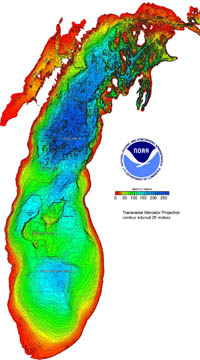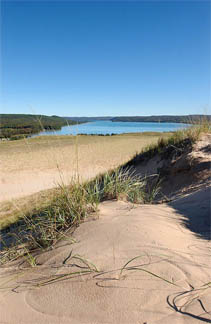Lake Michigan - the M in HOMES
The acronym HOMES helps us remember the names of the five Great Lakes. This article focuses on the M in HOMES—Lake Michigan.
Lake Michigan is the 6th largest freshwater lake in the world, and the third largest Great Lake. It is
the third largest of the Great Lakes if measured by surface area (22,300 square miles) or average depth (279 feet), but ranks second in maximum depth (925
feet) and volume (1,180 cubic miles). Its shoreline is 1,640 miles in length; it sits at an elevation of 577.5 f eet above sea level, and has a water retention/replacement
time of 62 years.
eet above sea level, and has a water retention/replacement
time of 62 years.
Its northern edge joins Lake Huron at the Straits of Mackinac, making the two lakes hydrologically inseparable. Lake Michigan is a long, narrow cul-de-sac, with almost all of its water flowing out through the straits after circulating in the lake for more than six decades. A small amount is diverted to the Mississippi River basin through the Chicago Sanitary and Ship Canal.
Four states – Michigan, Indiana, Illinois and Wisconsin – border the lake, and it is the only Great Lake entirely within the United States. The northern part of the Lake Michigan basin is covered with forests and is sparsely populated, whereas the southern portion is rich in agriculture and heavily industrialized with large metropolitan centers, including Chicago and Milwaukee.
The geographic diversity of the Lake Michigan basin makes it suitable for a wide range of economic sectors. The largest concentration of
steel production in North America is in t he metropolitan areas surrounding southern Lake Michigan, including Chicago, Illinois and Gary, Indiana. Six of
the top ten agricultural counties in Michigan are in the Lake Michigan basin. Traverse City, which sits on Lake Michigan’s shore, has been named the “Cherry Capital
of the World.” Michigan also produces the fourth largest grape harvest in the nation.
he metropolitan areas surrounding southern Lake Michigan, including Chicago, Illinois and Gary, Indiana. Six of
the top ten agricultural counties in Michigan are in the Lake Michigan basin. Traverse City, which sits on Lake Michigan’s shore, has been named the “Cherry Capital
of the World.” Michigan also produces the fourth largest grape harvest in the nation.
Lake Michigan supports a multimillion dollar outdoor recreation industry, including fishing, diving and boating. Some of the basin’s greatest attractions are the magnificent freshwater dunes that line the Michigan, Illinois and Indiana lakeshores. More than 20 million people visit national lakeshores, state parks and underwater preserves in the basin, annually.
Michigan State University Extension and Michigan Sea Grant offer many educational programs to those along the Lake Michigan shore—from anglers, swimmers and boaters to sport divers, marinas and the commercial fishery. We collaborate with other state Extension programs and regional groups bordering Lake Michigan, such as the Great Lakes Sea Grant Network, the Great Lakes Observing System, COSEE Great Lakes, the Great Lakes Restoration Initiative, and the Great Lakes Stewardship Initiative. Through these collaborations, MSUE and Michigan Sea Grant are able to provide additional opportunities to those who live and work in Lake Michigan’s basin as participants in the Great Lakes Literacy Initiative.
This article was adapted from MSU Extension Bulletin E-1867 (October 2000) – Lake Michigan Basin.


 Print
Print Email
Email




